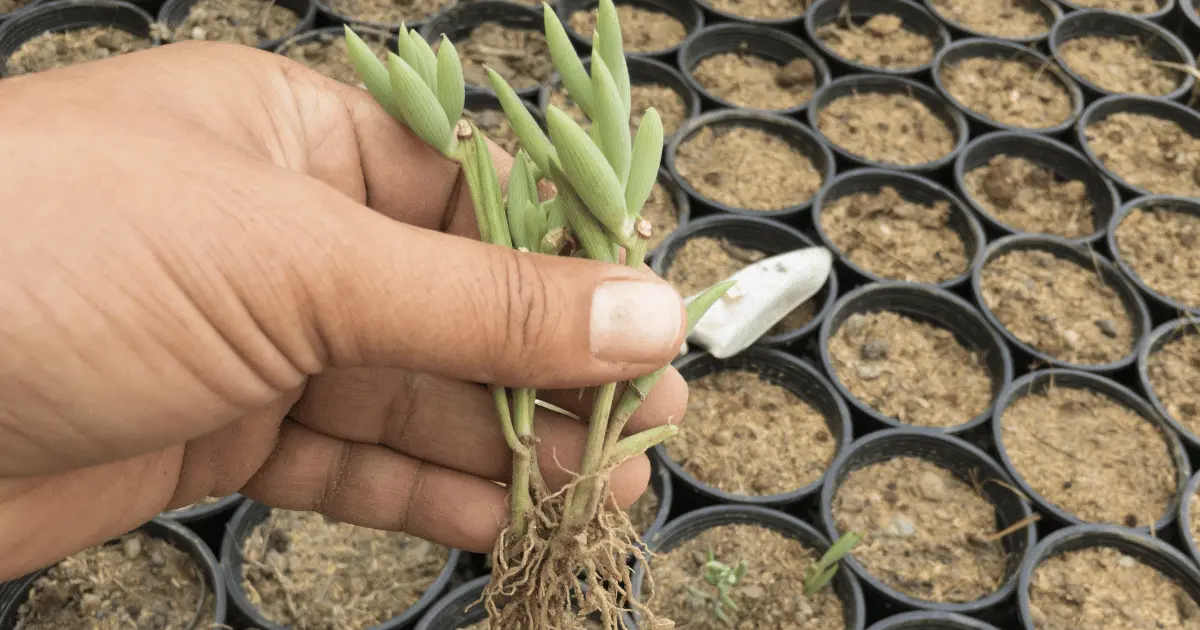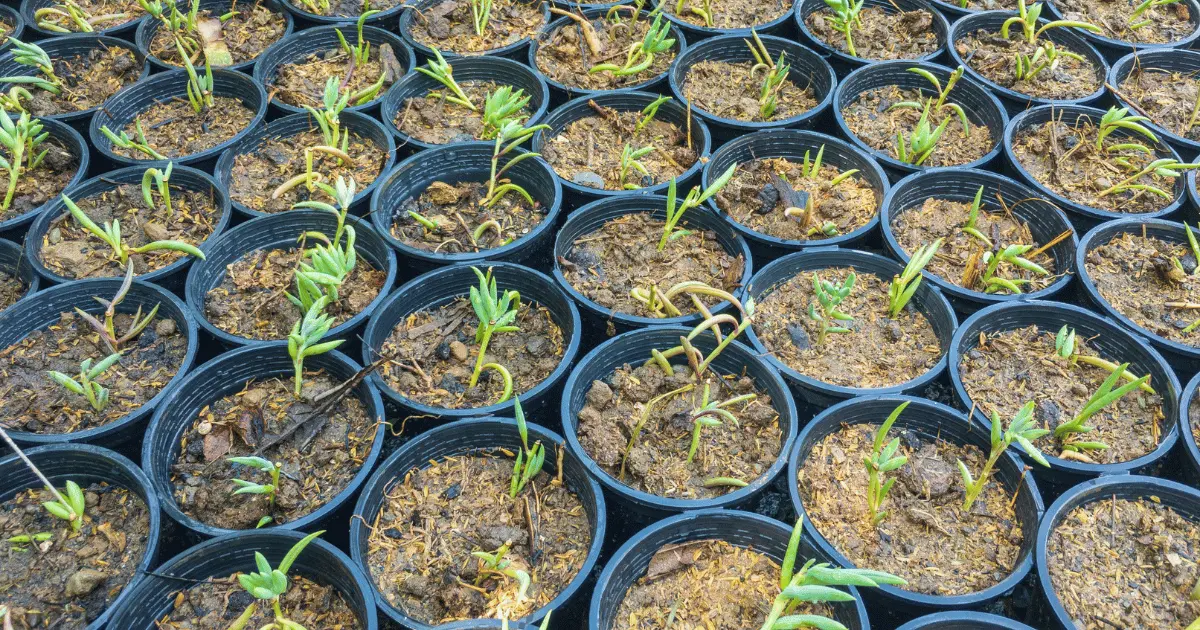A string of Bananas is recognized as one of the most efficient low-maintenance garden plants; easy to propagate and lovely to include as an indoor or outdoor decorative garden plant. They’re a model hanging plant that’s best potted in a hanging basket where their distinctive banana-shaped vines can easily flow downwards in a brilliant cascade.
Known scientifically as Senecio radicans, a string of Bananas is intimately similar to the popular String of Pearls in many ways, but they can be propagated much easier and faster. This particular garden plant’s characteristic appeal is the outline of its gleaming banana-like foliage, which develops from extended dropping clasps.
Propagating String of Bananas

It’s best to propagate a String of Bananas by stem cuttings which can be rooted in water, a potting mix, or by Layering. Let’s discuss each method in greater detail.
Growing String of Bananas from Stem Cuttings
Making your Banana Strings cuttings requires no special skill, and even first-time gardeners can do it effortlessly. All you need is a pair of scissors or a kitchen knife to cut the mature stems off the parent plant.
Each cutting should be at least 6 4-6 inches long and bear 3-4 leaves. Make the cuts right at the base of the stem, directly below the leaf nodes; after which, we can now grow the cuttings in water or a soil mix potting.
Selecting the right stems to make cuttings will greatly impact the success of the entire propagation, so take adequate measures to choose only the healthiest and strongest ones.
Stems that look weak, pale, discolored, or infected will have difficulty rooting. It would help if you allowed your cuttings to rest for a few hours, up to a day, after cutting so that the cut edges can heal before planting them.
Rooting your Banana Strings Cuttings in Water
Rooting in water is a common method of growing a new String of Bananas, and it doesn’t require a lot of materials to get done. All you need is a clean flower vase or glass jar with water; the water should stay under 3 inches to prevent any leaf from getting in.
Place your stem cuttings in the water vase and set it up on a plane surface with brilliant lighting for two to three weeks, and the young roots will begin to appear. You should remove any residual leaves at the base of the lower edge of the cuttings so that they don’t rot in water, leaving only the leaves at the tips of the cuttings.
Always remember to replace the water in the vase regularly to avoid the accumulation of fungi spores. You can now transplant your tender rooted cuttings in a potting mix when the new roots are 1-2 inches long; keeping them in water for longer might cause them to rot.
Rooting your Banana Strings Cuttings in a Soil Mix Potting

Growing your Banana String Cuttings in water has several benefits over growing them in water. But the most important is that there’s no risk of the rooted cuttings getting damaged or breaking while attempting to transplant them.
Pour a quantity of the soil mix into the rooting pot and stick the cuttings in at a depth of not more than 1 inch. You may wish to apply rooting hormones such as honey, cinnamon, and sugar or a commercial rooting powder; these all help root the stems faster and hinder the growth of infectious microorganisms.
If the rooting hormone is available, pour some of it on a plain sheet of paper, and dip the calloused edge of the cuttings in it, before sticking it into the soil mix potting. It’s advisable to water your potting immediately after planting until it begins draining off, then set it on a flat surface to drain the surplus water completely.
Place the pot on a brightly lit surface with plenty of indirect sunlight and water it regularly; the cuttings will begin to root in 2-3 weeks.
Propagating Banana Strings by Layering
Layering is a unique method of growing new Banana String pots, and the process is equally not so technically demanding. All you need to do is find the leggy stems closest to the plant with well-grown leaves and nodes.
Bend these stems to touch the potting soil surface in the pot and fix them in position using tape or binding wire. These bent stems don’t need to be cut off the mother plant to start growing roots after a few weeks.
You can now cut off the rooted stems and grow them as stem cuttings; the trick is, any part of the stem with leaves will begin to root once it touches the potting soil and is held in that fixed position for up to two weeks.
Sunshine Requirements of String of Bananas
String of Bananas are also called ‘happy creepers’ because they actively grow and spread, covering all available spaces in a short time, as long as they’re propagated in a brightly illuminated spot indoors.
They can drink more of the shining direct sunlight during the day for up to six hours before returning them indoors, but you shouldn’t take your eyes off them in the first few weeks to observe how they’re responding to the bright sunlight.
They’re mostly intolerant to extreme weather conditions, so ensure they’re included during the very hot summer days or extremely cold winter nights. They easily suffer sunburns with scorched leaves when exposed to direct sunshine for too long, but if the available light gets too low, they also begin to look leggy with scanty stems, making them look abandoned.
Choosing the best spot to position their pots is crucial to their survival. Most Banana Strings are adapted for Warmer tropical climates, but excessive heat can be counterproductive. Place them outside heat sources in the home, such as air vents or behind refrigerators.
Best Potting Soil Mix to Propagate String of Bananas
A string of Bananas generally flourishes well in a well-aerated, quick, draining, lightweight potting mix with much grit and organic matter; any commercial cactus potting mix, orchids soil mix, or succulents mix is ideal for them.
It would help if you potted them in a soil mix with a pH of 6.6-7.5. a great potting mix sample would consist of 40% cactus or succulents mix, 20% horticultural pumice, 20% sharp sand, and 20% perlite. Getting this formula into your homemade potting blend will doubtless yield desired results.
Watering your String of Banana Pots
Most Strings of Bananas are inherently resistant to droughts and desiccation, being succulents with a history traceable to the South African tropical forests. But that should be distinguishable from their intolerance to dampness and high humidity.
They’ll always prefer to be potted in a dry, slightly moist environment, but the leaves shouldn’t be damp and soaked in water for too long, or they might begin to rot. Potting them in a soil mix that retains water too much can also lead to root rots as well.
Their water needs in summer when they’re actively growing is slightly more than they require during winter when they’re resting. It would be best if you only water them thrice a month during summer and only once in two weeks during winter.
Banana Strings prefer bottom watering, which allows their leaves to remain dry and moist. You should limit misting and spraying them to their earlier stages of development and stop misting once they grow above 10 feet. To be safer, you should only water them when the potting soil seems dry and powdery.
Is String of Bananas Toxic to Humans?
They demonstrate soft toxicity in people if their leaves and seeds are consumed or their fluids contact the skin. Common symptoms of toxication include diarrhea, vomiting, and skin rashes. They also cause a higher degree of toxicity in children and pets such as dogs and cats with varying degrees of toxication.
Conclusion
Unlike most other succulents, which are propagated for their flower blooms as well as exquisitely pigmented foliage, String of Bananas are more commonly propagated for their identical decorative leaves; these can be beautifully patterned into various shapes, forms, and designs, and every gardener gets to put their aesthetic creativity to good use.
When propagated in an outdoor garden, ensure that they’re allowed enough space to crawl and spread because growing them in confined places limit their development.
Since they are more appealing when they grow long tendrils that can be rolled into thick balls or allowed to flow in beautiful cascades, confined spaces are absolutely detrimental to their floral beauty.
